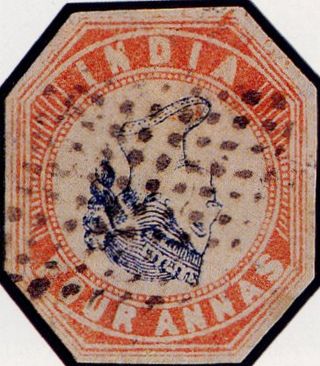Related Research Articles

Philatelic literature is written material relating to philately, primarily information about postage stamps and postal history.

The Uganda Cowries, also known as the Uganda Missionaries, were the first adhesive postage stamps of Uganda. Because there was no printing press in Uganda, the stamps were made on a typewriter by the Rev. E. Millar of the Church Missionary Society, in March 1895, at the request of C. Wilson, an official of the Imperial British East Africa Company. After Millar received a much-needed new ribbon, the color of the typewritten characters changed from black to a violet color. The stamps were valid for postage within the Kingdom of Buganda; in adjoining kingdoms and provinces they were used only for communications between officials of the Church Missionary Society.

The Inverted Head Four Annas of India is a postage stamp prized by collectors. The 1854 first issues of India included a Four Annas value in red and blue. It was one of the world's first multicolored stamps; the Basel Dove preceded it by nine years. However, an invert error occurred during production, showing the head "upside down."

John Harry Robson Lowe was an English professional philatelist, stamp dealer and stamp auctioneer.
Colonel Denys Richard Martin was a distinguished 20th century philatelist. As a systematic scholar and prolific writer, Martin illuminated some of the most difficult topics and set a high standard for the study of the postage stamps and postal history of India and Burma.

This is a survey of the postage stamps and postal history of Tibet.

Frederick John Melville was a British philatelist, prolific philatelic author and founder of The Junior Philatelic Society. He was also a founder in 1907 of the Philatelic Literature Society. Melville is a member of the American Philatelic Society's Hall of Fame and was a signatory to The Roll of Distinguished Philatelists in 1921.

The Roll of Distinguished Philatelists (RDP) is a philatelic award of international scale, created by the Philatelic Congress of Great Britain in 1921. The Roll consists of five pieces of parchment to which the signatories add their names.
Gary Sidney Ryan (1916–2007) was an eminent philatelist who specialised in the stamps and postal history of Hungary and later in revenue stamps.
David Richard Beech MBE was the curator of the British Library Philatelic Collections from 1983–2013. He is a fellow and past president of the Royal Philatelic Society London (RPSL). In 2013, it was announced that Beech was to receive the Smithsonian Philatelic Achievement Award for outstanding lifetime accomplishments in the field of philately.

Herbert Edgar Weston, or H. Edgar Weston, was a stamp dealer in Stockwell, London, then Twickenham, who used the pseudonym Victor Marsh and who purchased Jean-Baptiste Moens' stock of philatelic literature after Moens' retirement in about 1907. Weston claimed to have the world's largest stock of philatelic literature for sale. He was also a prolific producer of philatelic covers using cut-outs from stamped to order postal stationery items. In 1907, Weston was a founder member of the Philatelic Literature Society.

The International Philatelic Union, formed 1881, was an early international philatelic organisation formed for the study of stamps and the promotion of philately generally. Its office was located in London. The society survived to see its jubilee in 1931, and an exhibition was held to celebrate the fact, but its later history is unclear.
Wing Commander Peter Ingram Padget LDS of Weston-super-Mare, Somerset, was a Royal Air Force officer and philatelist who was a specialist in the stamps of China. He wrote extensive on the subject and his articles appeared in Gibbons Stamp Monthly, the China Clipper, the Journal of Chinese Philately and The London Philatelist.

James Bendon is a stamp dealer, publisher, and philatelist who is an authority on specimen stamps. He wrote and published the first worldwide catalogue of Universal Postal Union specimen stamps and subsequently published philatelic books by authors such as Robson Lowe and James Negus.

Francis Hugh Vallancey was a schoolmaster, philatelist, philatelic author and editor, and dealer in philatelic literature. His business was destroyed during the London Blitz of 1941, but he rebuilt it after the war before ill health forced his retirement.

Henry Garratt-Adams was a British philatelist, philatelic publisher and dealer in philatelic literature based in Kinnersley Castle in Herefordshire, England. After his death, a large hoard of philatelic literature was found at the castle that included many rare items dating to the earliest days of philately.
Wolfgang Baldus is a German graphic designer, artist, and philatelic writer. He is known for authoring and publishing books on cinderella stamps in the series History and Background Stories of Unusual Stamps and for his works on the philatelic forgeries and propaganda parodies produced by both sides during the First and Second World Wars.
Ezekiel Victor Toeg FRPSL was a British solicitor and philatelist who specialised in the postage stamps and postal history of the British West Indies (BWI) and Caribbean. His collection of Antigua won two gold medals at international stamp exhibitions and included a 1693 letter to London that was described in 1990 as the earliest known letter from the island. He wrote a book on the adhesive fees stamps of the Leeward Islands (1991) and completed a survey of the stamps and postal history of the island of Dominica to 1935 (1994). He was president of the British West Indies Study Circle (BWISC) from 1968 until his death in 2010.
Wilfrid Thomas Froggatt Castle was a British Church of England clergyman, author, and philatelist who wrote on the history and philately of the former Ottoman Empire, and of Cyprus in particular.
References
- ↑ Bateman, Robert. Stamp collectors' who's who. London: Stanley Gibbons, 1960, p. 90.
- ↑ Birch, Brian. (2012) Biographies of philatelists and dealers Archived 6 April 2016 at the Wayback Machine . 12th edition. Standish, Wigan: Brian Birch, p. 2116.
- ↑ "Books" in Gibbons Stamp Monthly, December 1981, p. 65.
- ↑ "End of season results" in Gibbons Stamp Monthly, October 1979, p. 64.